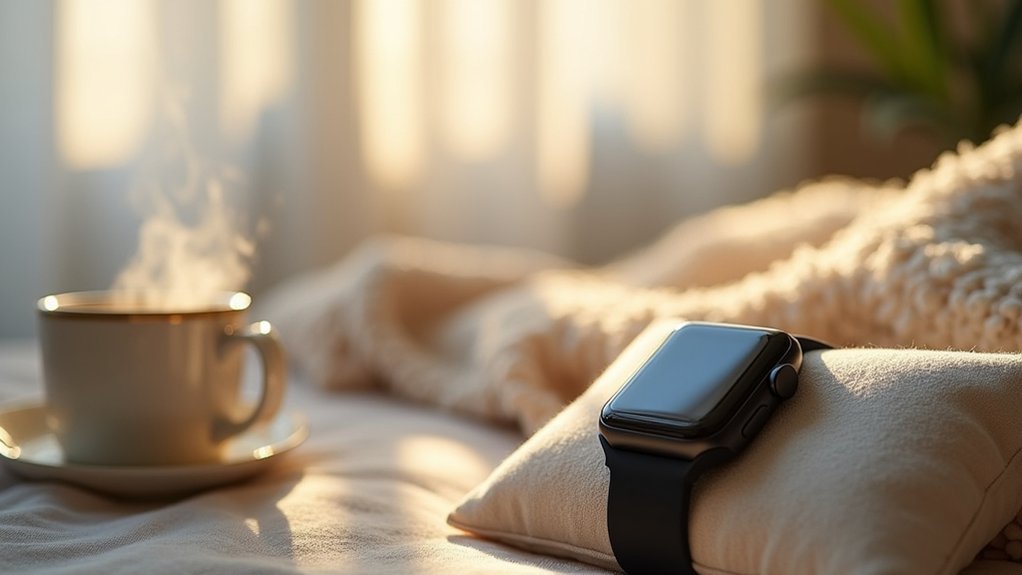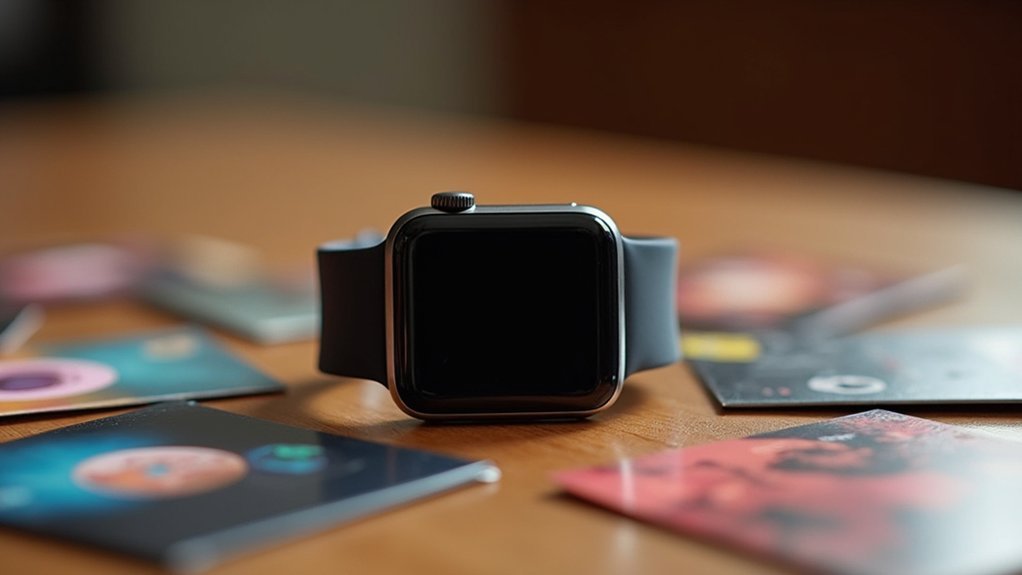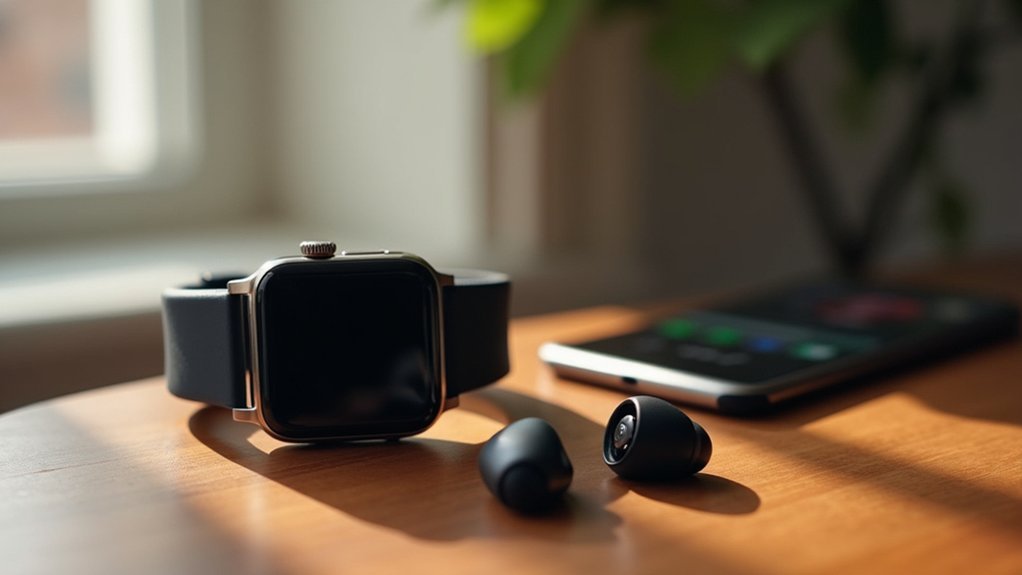Choose a lightweight sport watch with AMOLED display and excellent battery life for comfortable nap tracking. Enable automatic nap detection in your device settings and set a 10-20 minute minimum duration threshold. Position the watch 1-2 finger widths above your wrist bone for accurate sensor readings. Activate Do Not Disturb mode and use smart alarms that wake you during light sleep stages. Analyze your nap data to identify ideal timing patterns and monitor how naps affect your nighttime sleep quality. These techniques will help you access your watch’s full potential for better rest.
Choose the Right Sport Watch for Comfortable Nap Tracking
When selecting a sport watch for nap tracking, you’ll want to prioritize features that enhance both comfort and functionality during rest periods.
Consider the Coros Pace 2’s extremely lightweight design, which won’t feel bulky on your wrist during sleep. Look for AMOLED displays like those in the Garmin Forerunner 965 or Coros Pace Pro—they’ll provide vibrant visuals without straining your eyes when checking the time.
Lightweight designs and AMOLED displays ensure comfortable sleep tracking without wrist bulk or eye strain during nighttime checks.
You’ll appreciate touchscreen capabilities like the Garmin Fenix 8 offers for quick interactions without fumbling with buttons. Choose adjustable straps for a secure yet comfortable fit, though avoid nylon materials that might become soggy with moisture.
Prioritize watches with excellent battery life, such as the Garmin Enduro 3 with solar charging or the Amazfit T-Rex 3’s three-week lifespan, ensuring uninterrupted tracking. The Coros Pace 3 offers up to two weeks of typical use with its impressive battery performance.
Optimize Your Watch Settings for Automatic Nap Detection
Once you’ve selected the perfect sport watch for nap tracking, proper configuration becomes your next priority for seamless automatic detection.
First, update your watch’s firmware to access the latest nap tracking features—WatchOS 11 and recent Garmin models offer enhanced capabilities.
Navigate to your device’s sleep settings and enable automatic nap detection, which typically requires periods of inactivity combined with sleep-like biometric patterns.
Configure your minimum nap duration threshold, usually starting at 10-20 minutes.
Enable Do Not Disturb mode to minimize interruptions and improve tracking accuracy. Some watches automatically activate sleep mode during detected naps, providing more sensitive monitoring.
Set custom nap alerts if you prefer timed sessions. For enhanced precision, consider using the manual nap tracking feature through your watch’s nap glance when you know you’ll be resting.
Regular firmware updates guarantee you’re utilizing the most accurate detection algorithms available.
Wear Your Device Properly for Accurate Biometric Readings

Proper device placement forms the foundation of accurate nap tracking, as even the most advanced sport watches can’t deliver reliable biometric readings without perfect sensor contact. Skin pigmentation can interfere with sensors, making proper positioning even more critical for consistent measurements.
Position your watch 1-2 finger widths above your wrist bone to guarantee ideal photoplethysmography signals while avoiding bony prominences that disrupt blood flow detection.
Your watch’s fit directly impacts data quality during rest periods:
- Snug but not restrictive – maintain steady sensor contact without cutting off circulation
- Consistent placement – wear it in the same spot every nap to reduce measurement variability
- Clean sensor regularly – remove sweat and oils that scatter light and compromise accuracy
- Dry before wearing – moisture creates signal noise that affects heart rate readings
- Avoid additional accessories – they interfere with optical sensors during naps
Use Smart Alarms and Do Not Disturb Features During Naps
While your sport watch collects sleep data continuously, it’s the smart alarm and Do Not Disturb features that transform raw biometrics into actionable nap enhancement.
Smart alarms use accelerometer and heart rate data to detect lighter sleep stages, waking you when you’ll feel most alert rather than groggy. This timing matters most for naps under 90 minutes.
Smart alarms detect your lightest sleep phases, ensuring you wake up refreshed instead of drowsy from poorly-timed naps.
Activate DND mode to prevent notifications from fragmenting your sleep. You can customize alarm windows 15-30 minutes before your target wake time, allowing the device to find ideal moments within that range. Set DND to full silence or allow priority alerts based on your needs.
These integrated features work together—sleep monitoring feeds algorithms that automatically manage both alarm timing and notification blocking for seamless nap management. Since sleep trackers estimate sleep based on measured inactivity rather than direct measurement, the accelerometer data becomes crucial for determining when you’ve actually fallen asleep during your nap.
Analyze Your Nap Data to Improve Sleep Quality and Timing

After collecting weeks of nap data, your sport watch transforms from a simple tracker into a personalized sleep coach.
You’ll discover patterns that reveal your ideal nap windows and durations. The data shows when 10-20 minute power naps boost your alertness versus longer 90-minute cycles that might disrupt nighttime sleep.
Your watch tracks sleep stages, heart rate variability, and breathing patterns during naps, helping you identify what works best for your body. Modern devices can detect breathing disturbances with high accuracy, potentially identifying sleep issues that affect both naps and nighttime rest.
Use these insights to refine your napping strategy:
- Spot your sweet spot – Find when naps enhance rather than hinder nighttime sleep
- Avoid sleep inertia – Wake before deep sleep stages to prevent grogginess
- Track recovery benefits – Monitor how heart rate and mood improve post-nap
- Detect breathing issues – Identify snoring or oxygen disruptions affecting nap quality
- Maintain consistency – Align nap timing with your natural circadian rhythms
Frequently Asked Questions
Can Sport Watches Differentiate Between Naps and Nighttime Sleep Automatically?
Yes, you’ll find advanced sport watches can automatically differentiate between naps and nighttime sleep using heart rate, movement, and timing algorithms, though accuracy varies by device and isn’t perfect.
How Long Should I Nap for Optimal Recovery According to Watch Data?
You’ll want to nap for 30-60 minutes according to ideal recovery data. This duration improves physical performance without causing sleep inertia, which your watch can track to help refine timing.
Will Frequent Napping Affect My Nighttime Sleep Quality Measurements?
Yes, frequent napping will negatively impact your nighttime sleep quality measurements. You’ll likely see increased sleep fragmentation, longer time to fall asleep, shorter nighttime duration, and more awakenings on your watch.
Can Sport Watches Track Power Naps Under 20 Minutes Accurately?
Sport watches struggle to accurately track power naps under 20 minutes. You’ll find they often miss short naps entirely or misclassify quiet rest as sleep since their algorithms aren’t optimized for brief sleep sessions.
Do Certain Sleep Positions Affect Nap Tracking Accuracy on Sport Watches?
Yes, your sleep position greatly affects nap tracking accuracy. Lying on your watch arm dampens motion signals, while side sleeping can alter heart rate readings. Back sleeping typically provides the most reliable sensor data.
In Summary
You’ll maximize your napping potential by implementing these sport watch strategies. Don’t forget to choose a comfortable device that won’t disrupt your rest, configure settings for seamless tracking, and position it correctly for accurate data. You’re setting yourself up for success when you utilize smart features and analyze your patterns. Your sport watch isn’t just for workouts—it’s your ultimate napping companion for better recovery and energy.





Leave a Reply